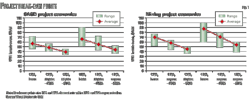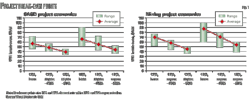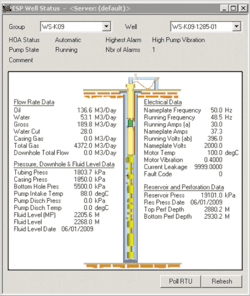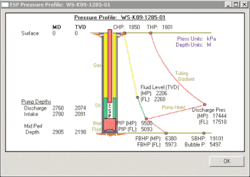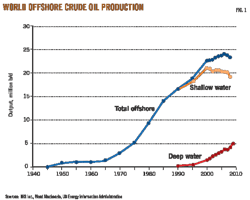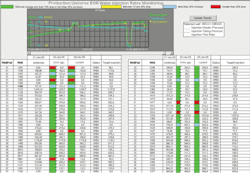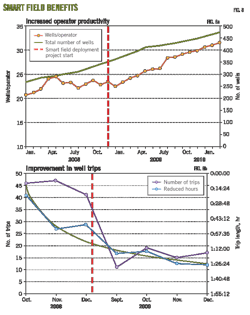Ron Cramer
Robert Tulalian
Shell Global Solutions
Houston
Andrew Mabian
Salym Petroleum Development NV
Salym, Russia
Automation in Salym field of western Siberia has reduced operator travel and hazard exposure, reduced interruption in electric submersible pump operations, and provided more stable operations and faster restarts.
Salym Petroleum Development NV, a joint-venture company, operates the field, which has variable-speed-drive ESPs in about 330 wells and well instrumentation tied into supervisory control and data acquisition and historian systems.
Shell's FieldWare suite of applications provides real-time monitoring, surveillance, and control of the wells. The software is linked electronically to offline integrated production system models and the hydrocarbon accounting system.
In this application, FieldWare has four modules:
1. Production Universe, an application for real-time tracking oil, gas, and water flows of all wells.
2. ESP, an application for obtaining real-time pump efficiency curves, reports, surveillance, and remote control. Real-time echometer fluid level measurements complement this application.
3. EOR, an application for optimizing water injection and providing real-time tracking of water flows from source to injection, including real-time monitoring levels in surface vessels, surface pumps, and injection pressures.
4. WellTest, an application for optimizing well tests. The software enables real-time well test automation (determination of when the test is done, identification of the next well to be tested, and advising the operator accordingly) measurements screening, troubleshooting, and automatic transfer of test data to the hydrocarbon accounting system.
A comparison of the automated and yet-to-be automated parts of the field illustrates the benefits of automation.
Salym infrastructure
The Salym group of oil fields in Western Siberia (Fig. 1) has tough Siberian climate conditions.
The fields have about 400 directional wells drilled from 24 pads in difficult surface conditions such as marshes. The pads minimize the environmental footprint and optimize the infrastructure costs.
One aim of the company is to reduce personnel travel to remote wellhead locations so that personnel encounter fewer travel hazards as well as cause less environmental disturbance in this pristine area.
Development of the fields continues with the drilling of about 100 new wells every year. The field operations involve water injection for reservoir pressure maintenance and variable-speed-drive ESPs on all producing wells.
Electronic instrumentation on the producing wells include:
• Surface control units for facilitating remote and local ESP speed adjustment.
• Local or remotely operated surface production chokes.
• Surface pressure and temperature tubinghead gauges.
• Surface ESP electrical measurements such as frequencies, volts, amps, power, power factor, loading, and vibration
• Bottomhole pressure and temperature gauges.
• Some wells with remotely controlled automatic echo gauges for measuring the casing liquid level.
Injection wells have surface injection chokes that can be operated remotely for adjusting the water injected in each well and surface flow, pressure, and temperature gauges.
The electronic instrumentation in the surface production facilities provide:
• Bulk flows of produced oil, gas, and water.
• Bulk flows of injected water.
• Various vessel levels and pressures.
• Pump status.
• Automated test separator flow and pressure measurements.
A supervisory control and data acquisition system streams all real-time data from the aforementioned electronic instrumentation to a data historian and telecommunications system so that the data are available continuously in the field and field and head offices. These data facilitate manned and remote operations as well as exception-based surveillance and control of the entire facility. Fig. 2 illustrates the electronic data flow.
The software applications continuously transform raw electronic data into useful, actionable information such as oil, gas, and water flows for all of the ESP wells and electronic calibration of modeling and accounting systems.
It is one thing to have good data and quite another to have good information that allows timely decisions to optimize field operations. Consequently as part of Salym's smart fields initiative, the company has installed software applications that transform the aforementioned stream of real time data into actionable information. These software applications include:
• Continuous well flow monitoring.
• ESP monitoring.
• ESP performance envelope monitoring.
• ESP pump control.
• Water injection monitoring and control.
• Test separator monitoring.
Continuous well flow monitoring
An exception-based surveillance software application (FW-PU) continuously estimates oil, gas, and water flows for all wells. The software models are data driven from data stemming from well tests at different rates.
The software continuously reconciles the sum of the estimated well flows with real-time process measurements of total oil, gas, and water. References 1 and 2 further describe the approach.
Shell's experience indicates that this data-driven modeling approach has several advantages:
• The approach is mature and well proven with more than 5 years of field operation experience.1 2
• It is sustainable because the models are based on well testing that is intrinsic with production operations;
• The approach has a large installed base, with the software running on 2,000 wells that produce 2 million b/d.
• Data-driven models facilitate well testing by exception. This eliminates testing of wells in which flow has not changed and results in reduced test frequency and less visits to remote sites.3
• The models can handle static and transient conditions, thus automatically accounting for produced fluids during process start up and upsets. In addition, operations can use these data-driven models to account for unexpected production increases and decreases.4
• Data-driven models are equally applicable to all sizes and most types of wells, which makes them suitable for standard application across an entire field and facility, for example, production allocation.4
All Salym ESP wells use the application for exception-based well surveillance in which the application quickly identifies any change in a well's performance so that operations can initiate corrective action. For example low liquid production may indicate pump-performance problems.
Detection of water flow can be more subtle because of difficulties in discriminating between real process changes, instrumentation problems, and underlying model problems. One can usually resolve these difficulties by running multiple FW PU data-driven models based on different well parameters such as a model based on tubinghead pressure and another based on tubinghead temperature. If both models change correspondingly, it probably is not an instrumentation problem.
A quick well test will confirm that it is not a model problem and confirm that the water cut has changed.
An indication of instrumentation problems is if one of the data-driven models changes but not the other. In this case, the system will raise an alert to flag for the problem instrument.
Note that much of this detection process is automated. The application creates the multiple models automatically during the well-test process and the automated surveillance options provide maximum information with minimal effort.
ESP monitoring
A software application (FW-ESP) continuously monitors and controls all of Salym's 330 producing wells with ESPs. The application comprehensively describes the well and pump assembly in terms of configurable parameters such as casing and tubing dimensions, deviation, perforation depth, well mechanical and completion details, fluid properties, pressures, flow rates, pump parameters, and motor and motor controller details.
The application monitors the ESP with pump efficiency curves that immediately show if the pump is operating within the sweet-spot area. Remote pump control actions include stop, start, slow-down, and speed-up.
This screen shows an overview of key real time and static surveillance data for a typical Salym well (Fig. 3).
For effective pump surveillance, an engineer needs timely, meaningful real time information at his or her fingertips. Fig. 3 is an overview showing a combination of key real time and static surveillance data for a typical Salym well.
Interfacing the FW ESP with FW PU applications allows the engineer to relate well productivity to pump speed for continuous optimization. The well production rates shown in Fig. 3 may be automatically derived from PU to aid continuous pump surveillance and optimization. One can also obtain pump productivity from well testing; however, these data may be out-of- date and potentially misleading if well testing is infrequent.
A two-phase flow model allows continuous derivation of the downhole pump pressure profile and dynamic head (Fig. 4).
The application also incorporates a two-phase flow model that allows continuous derivation of the downhole pump pressure profile and dynamic head, again as a surveillance and optimization aid (Fig. 4).
The application displays data on the state of the pump, performance trends, and anomalies. Outputs include total dynamic head and inflow performance relationship plots, pressure profile displays, and performance reports.
Tabular reports show the results of analysis, such as downtime, the number of starts and the cumulative run hours. The application stores the results that one can access graphically or as performance history reports.
ESP optimization
A key optimization graphic (Fig. 5) is the pump performance curve, which is derived on demand. The figure displays catalogue (as new), actual, and predicted production vs. pressure curves.
The FW-ESP application again can automatically derive the well production rates from PU to continuously provide the operating point on the performance curve and facilitate operation within the sweet spot for maximum pump run life and optimal production.
ESP control
The company is working towards automatically controlling ESPs (closed loop) by continuously measuring the liquid level above the pump with echo sounding devices.
In this process, the pump automatically will slow down when the liquid level falls and will speed up when the level rises, thus automatically maintaining the required net positive suction head above the pump.
Automatic NPSH control in conjunction with manual monitoring of the continuously updated pump efficiency curve will ensure an optimized "sweet-spot" performance. Also following analysis with the aforementioned pressure profile, inflow performance relationship curve, well productivity, and pump performance curve, the operator can immediately adjust pump speed, either for increased production or so that the pump's performance parameters stay within the allowable operational envelope to maximize pump life.
The FW ESP software provides early warning of impending pump problems, recognizes pump upsets or failures, and automatically captures detailed information at the time of the incident. One can replay these data to facilitate quick, efficient analysis of well or pump problems. If a new pump has to be installed, the data can be used to help optimize the design and the operating envelope for increased ESP productivity and run-life.
Water injection
The FW-EOR application continuously measures or estimates water flow into all injection wells. A traffic light display informs the operator of the status of the entire injection system (Fig. 6).
The application provides an overview of daily water injection for real-time monitoring actual vs. planned injection from the 90-day plan.
The traffic light system enables direct focus on problematic wells and aids in determining remedial actions for improving water injection performance. This enables production and injection optimization within constraints, such as injection flow distribution, choke-size, and pressure drops.
Change management
It is one thing to install smart fields technology, but it is quite another to get it running, embedded, and then sustained over the life cycle. To accomplish this will involve changing the production process so that wells are brought to the operator instead of sending the operator to the wells.
Salym has been changing the work processes, roles and responsibilities, and organization to obtain the most effective smart fields utilization for establishing permanently one standard new system-based way of working.
This involves getting, keeping, and training the critical right people such as system champions, system custodians, superusers, megausers, project managers, implementers, and support staff, as well as making changes to the way they work so that the new technology is deployed effectively and sustainably.
Key to this has been:
• User training for more that 100 staff from field operations, ESP engineering, and production technology.
• Superuser training for systems administration, configuration, and maintenance.
• Megauser training for Salym trainers who can perpetuate the training process with local resources
• Development and deployment of standard operating procedures for exception-based monitoring of water production, handling, and injection performance and for troubleshooting using FieldWare technology.
The company now has embedded standard operating procedures within the daily production operations activities. It conducts user and superuser training when required.
Benefits
Evolving brownfield optimization provides an opportunity to quantify benefits of smart fields by comparing newly optimized parts of the field with prior, less-optimized operations,
The software applications have reduced the need for personnel to visit well pads because remote-based well surveillance enables operators to travel to wells by exception rather than on a fixed routine. Operators also can adjust remotely ESP speed and pump start and stop as well as wellhead chokes on ESP wells and water injectors.
In addition, the applications have reduced well testing because well tests are by exception instead of on a fixed schedule, and automatic measurement of fluid levels in the wells and fast transmittal provides data to those who need to know.
Another benefit from the implementation of the smart field technology was creation of a collaborative working environment that allows simultaneous real-time information access to staff in the head office and in the field. The entire staff views the same information at the same time, in the same format, and in the same context. This fosters improved teamwork as well as reduced site visits, problem solving, and optimization efforts.
The technology has reduced operator travel and work execution time associated with optimization, allowing operations staff to control and operate an increased number of wells with minimum health, safety, and environmental exposure during field pad visits (Fig. 7).
Fig. 8 shows that the time savings has allowed the existing operational staff to absorb extra activities associated with newly drilled and completed wells, and the wells required fewer trips and shut down hours.
The applications have improved ESP performance and reduced the number of failures. Results to date show a 0.3% reduction in overall field unscheduled deferment (Fig. 9).
Fig. 10 shows that the applications have stabilized operations by reducing variations in the average flowing bottomhole pressure. Well stabilization is conducive to increased production volumes and improved reservoir, well and surface process integrity.
Implementation and embedding of the technology in Salym's operations are continuing; however, the company has realized the following benefits to date:
• Reduced ESP trips because of increased ESP mean-time before failure to 650 days from 605 with projected operating cost savings of $2.5 million in 2010.
• More stable wells.
• Water injection that complies with requisite targets.
• 33% increase in operator productivity.
• Increased engineer and analyst productivity due to automatic model updates.
• Reduced unscheduled deferments by 3%.
And safer operations due to reduced operator travel to remote wellheads and hence reduced exposure to hazard, lower greenhouse gas emissions, and reduced environmental footprint, despite the increase in the number of wells.
References
1. Poulisse, H., et al., "Continuous Well Production Flow Monitoring and Surveillance," Paper No. SPE 99963, Intelligent Energy Conference, April 2006, Amsterdam.
2. Cramer, R., et al., "Well Test Optimisation and Automation," Paper No. SPE 99971, Intelligent Energy Conference, April 2006, Amsterdam.
3. Goh, K.C., et al., "Production surveillance and optimization with data driven models," Paper No. IPTC-11647, IPTC Conference, Dubai, December 2007.
4. Cramer, R., et al., "Improving Allocation and Hydrocarbon Accounting Accuracy and Automating Associated KPI's," Paper No. SPE 125178, ATCE, October 2009.
The authors
More Oil & Gas Journal Current Issue Articles
More Oil & Gas Journal Archives Issue Articles
View Oil and Gas Articles on PennEnergy.com
